This article was co-authored by Claudia Carberry, RD, MS. Claudia Carberry is a Registered Dietitian specializing in kidney transplants and counseling patients for weight loss at the University of Arkansas for Medical Sciences. She is a member of the Arkansas Academy of Nutrition and Dietetics. Claudia received her MS in Nutrition from the University of Tennessee Knoxville in 2010.
There are 10 references cited in this article, which can be found at the bottom of the page.
This article has been viewed 37,683 times.
It can be difficult to find a nutrition and exercise plan that feels realistic and achievable. You may feel overwhelmed with your career or with school and struggle to find time to exercise and eat healthy. With a little effort, you can develop a nutritional plan and an exercise plan that fit your lifestyle and your health goals. You should also focus on staying committed and motivated as you work out and eat right so you can maintain a healthier lifestyle long term.
Steps
Creating a Nutritional Plan
-
1Choose a diet that fits your goals and lifestyle. You should start by identifying your health goals and create a diet that fits your goals. This way, you are more likely to stick with your nutritional plan and feel a sense of accomplishment once your goals have been achieved.[1]
- For example, you may have a health goal of losing 10 pounds. You may then create a diet that allows you to track your calorie intake and only consume a certain amount of calories a day. You may then balance your nutritional plan with an exercise plan so you lose weight.
- You may also want to consider choosing a diet that fits your lifestyle. For example, if you tend to be busy during the week with school or work, you should sit down and create weekly meal plans so you can stick to your diet and lose weight. You may also plan to have workout sessions on the weekend when you have free time.
-
2Find a good weight-loss plan. You may decide to use an existing weight-loss plan as a model for your plan. There are many weight-loss plans out there, with different guidelines and steps. You may opt for a weight-loss plan that fits your health goals, your lifestyle, and your budget. Or you may try a weight-loss plan that has proven results and has worked for others in the past.
- For example, you may try Weight Watchers, which is rated the best weight-loss diet according to diet experts. On Weight Watchers, you can eat what you want but you will benefit more from making healthy choices. You are also able to shape your own diet and track your progress.[2]
- Another option is to try to cut out certain foods in your diet and opt for a specific diet, such as a vegan diet or a raw food diet. You may then focus on eating specific, healthy foods at every meal and cutting out foods that are processed, pre-packaged, and not fresh.
Advertisement -
3Track your calorie intake. To get a better sense of how many calories you are consuming every day on your diet, you should track your calorie intake. You can do this by counting the calories in your food every day to ensure you are eating enough food to stay energized but not too much to cause you to gain weight. You may calculate how many calories you need to eat every day to maintain a balance and then consider what meals you can have based on your daily calorie intake.
- You should calculate your calorie intake per day based on your lifestyle, your age, and your weight. You can then subtract 500 calories from your daily intake and make sure your diet is 500 less calories than it is normally.
- For example, you may decide you want to lose 10 pounds total. You should then aim to lose 1 to 2 pounds a week through diet and exercise. You may then focus on burning 500 to 1,000 calories more than you consume each day by working out, or reducing your caloric intake by 500-1,000 calories.
- There are a variety of apps for smartphones that you can download and use to track your calorie intake.
-
4Make weekly meal plans. You should stick to your nutritional plan by creating meal plans every week. This way, you know what you are eating and when you are eating. Make sure you have three square meals a day, as skipping meals can lead to binge eating and unhealthy food choices. Plan out your meals for several weeks and then make a shopping list so you know exactly what you are buying when you go to the grocery store.[3]
- You may use your daily calorie intake to help you choose foods for your meal plans. Go for foods high in nutrients and vitamins, but low in calories, so you can make the most out of your meal plan. Going for foods low in calories will also ensure you stay within your daily calorie intake.
- For example, you may have a 1,500 calorie limit as part of your diet. For breakfast, you may have a banana smoothie that is 250 calories, followed by a mid-morning snack of toast and ricotta with honey that is 150 calories. You may then have a power salad for lunch that is 400 calories, followed by an afternoon snack of fruit and nuts that is 150 calories. You may finish your day with a quinoa vegetable and tofu bowl for dinner that is 500 calories. You will then have around 1,450 calories for the day, meeting your dietary goal.
-
5Keep your portions small and controlled. You should also focus on how much you are eating every day by controlling your portions. Make sure your plate has a balanced portion of vegetables, fruits, protein, and grains. Try to go for portions that are small and manageable, as having portions that are too big can lead to overeating.[4]
- You can control your portions by using your hand to measure the food on your plate. You should have one finger's worth of dairy, such as a cheese stick and a fist sized serving of milk in a glass as a snack. You should also have one fist worth of vegetables on your plate as well as a protein source, like chicken or fish, the size of your palm. You should also have one fist size of fruit, such as an apple, as a snack.[5]
- You should also make sure you have small snacks throughout the day that are healthy and filling. Eating smaller portions throughout the day, rather than big meals, can help you lose weight and maintain your nutritional plan.
Building an Exercise Plan
-
1Select an exercise plan that fits your lifestyle and goals. When you are creating an exercise plan, you should focus on finding a plan that suits you and your needs. Consider your lifestyle and your fitness goals. You can then develop an exercise plan that fits your routine and feels achievable.[6]
- For example, you may have a goal of toning up your body and gaining more muscle. You may then develop an exercise routine that focuses on building muscle and toning key areas of your body.
- You may also realize that your lifestyle makes it difficult to devote hours to working out or spending a lot of time at the gym. You may then go for an exercise plan that you can do at home in your living room for 30 minutes a day. This way, you have enough time to get fit without disrupting your usual routine.
-
2Schedule a set time to workout. You should try to schedule in a set time to workout every day. Put the workout time in your calendar and try to stick to this time every day or every week. Having a set time for working out can make it easier to commit to it and feel like it is a natural part of your day.[7]
- You may block off workout time in your calendar at work so you are not available for meetings or other work events during your workout time.
- You may also let others know of your set workout time so they can schedule around your workout. This could be colleagues at work, family members at home, or friends at school.
-
3Integrate fitness into your daily routine. If you struggle to fit in set time to workout every day, you may try integrating fitness into your daily tasks. Take the stairs instead of the elevator and try to go for a walk or run at lunch. Do push ups or sit ups between meetings and do leg lifts while you are on the phone at work.[8]
- You may also try to walk and talk with friends or colleagues, rather than sit at a desk in a meeting to talk. Doing some movement or exercise for even 5-10 minutes at a time throughout the day can help you stay active.
-
4Challenge yourself to meet new fitness goals. After a few weeks to a few months on your exercise plan, you should assess your progress. If you feel you are achieving your goals, you may challenge yourself to create new fitness goals and then meet them. Challenging yourself will ensure you do not plateau and continue to stay in shape.[9]
- For example, perhaps you have reached your goal of losing 10 pounds. You may then challenge yourself to a new goal of toning up your muscles by doing strength building exercises. You may then create a new exercise plan that focuses on this new goal or add to your existing plan.
-
5Learn from a professional trainer. You may consider working with a professional trainer to help you develop an exercise plan, such as a trainer at your gym. Professional trainers can customize workouts for you based on your needs and can help motivate you to stay on track.
- You may also try taking a fitness class at your local gym to learn how to workout properly and effectively.
Sticking to Your Plan
-
1Stay motivated and committed. A big part of achieving your diet and fitness goals is staying motivated and committed. You should focus on staying motivated to achieve your goals, especially if they seem realistic and possible. Having clear goals, such as a goal weight, can help you stay motivated and committed to reaching your goal.[10]
- You may also find it helps to read motivational texts or posts on diet and weight loss on social media. You may put up motivational texts about fitness around your house or in your office to remind you to stay focused on achieving your goals.
-
2Keep track of your progress. It can also help to stay motivated to stick to your nutrition and exercise plan by tracking your progress on a day to day and week to week basis. You may create a document on your computer where you track your diet and your workout or use an app on your phone. Try to update the document or the app every time you eat and every time you workout.[11]
- You may also review your progress once a week to determine how well you are doing. You may then analyze your progress and note any weak spots or problem areas.
- For example, you may notice that you tend to drop in progress toward the end of the week, especially when you get busy at work or at school. You may then try modifying your workout plan so you do shorter workouts at the end of the week that still allow you to stay on track and reach your fitness goals.
-
3Find a support system. You can find motivation by reaching out to others for encouragement and support. You may enlist a friend or coworker to workout with you during lunch or on the weekends. You may join a fitness class with a friend and commit to going every week together. Or you may ask your partner to help you prepare healthy meals as part of your nutrition plan and avoid going out to eat at unhealthy places with friends.[12]
- You may consider working with a dietitian to help you develop a nutrition plan that is realistic and ideal for you. Consulting with a dietitian will ensure you are consuming enough calories every day to stay healthy.
References
- ↑ https://integrisok.com/resources/on-your-health/2021/january/pros-and-cons-of-different-diet-lifestyles
- ↑ http://health.usnews.com/best-diet/weight-watchers-diet
- ↑ http://www.mensfitness.com/nutrition/what-to-eat/back-to-basics-creating-a-healthy-diet-plan
- ↑ https://medlineplus.gov/weightcontrol.html
- ↑ http://www.healthyeating.org/Portals/0/Documents/Schools/Parent%20Ed/Portion_Sizes_Serving_Chart.pdf
- ↑ https://integrisok.com/resources/on-your-health/2021/january/pros-and-cons-of-different-diet-lifestyles
- ↑ https://www.afpafitness.com/blog/nutritional-goals-preparation-for-2015
- ↑ https://www.unh.edu/healthyunh/blog/physical-activity/2018/11/how-incorporate-fitness-your-everyday-life
- ↑ https://www.afpafitness.com/blog/nutritional-goals-preparation-for-2015
- ↑ https://www.betterhealth.vic.gov.au/health/healthyliving/physical-activity-staying-motivated
- ↑ https://www.afpafitness.com/blog/nutritional-goals-preparation-for-2015
- ↑ http://socialwork.buffalo.edu/resources/self-care-starter-kit/additional-self-care-resources/developing-your-support-system.html
- ↑ https://www.acefitness.org/acefit/fitness-fact-article/3575/a-smart-guide-to-goal-setting/ http://www.secondscount.org/healthy-living/healthy-living-detail?cid=14a1b2af-1631-4e88-b456-589ee370c2e8#.WPJ_Qf9OnMI


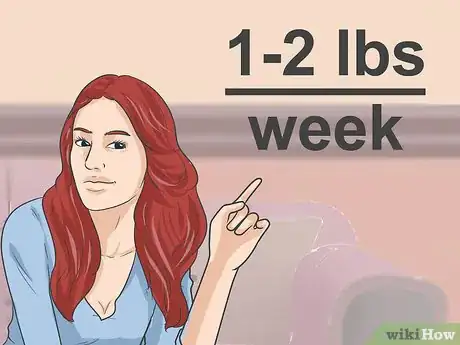


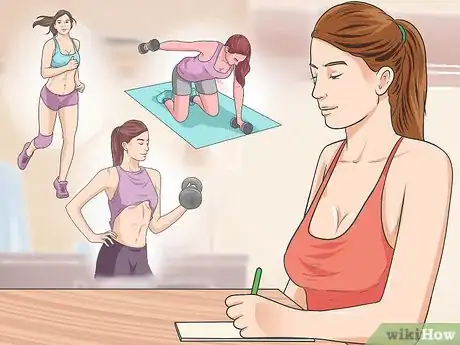


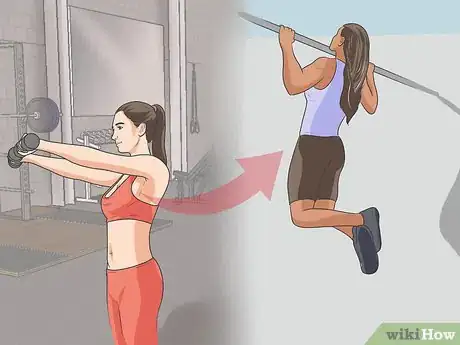





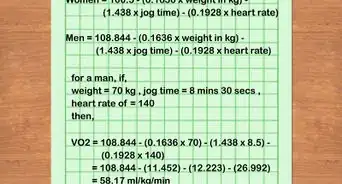



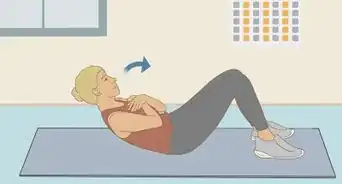












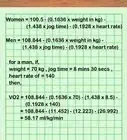





































Medical Disclaimer
The content of this article is not intended to be a substitute for professional medical advice, examination, diagnosis, or treatment. You should always contact your doctor or other qualified healthcare professional before starting, changing, or stopping any kind of health treatment.
Read More...